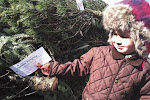Many parts of Ohio are dry and the corn crop is showing it. You can tell corn is experiencing moisture stress when its leaves are rolled up.
"Leaf rolling is indeed a response of the corn plant to insufficient plant moisture," said Bob Nielsen, Purdue University Extension corn specialist. "As plant moisture content declines, the corn plant often protects itself from excessive plant moisture loss by rolling its leaves. The rolled leaf offers less exposed surface area, so moisture loss is reduced. The act of leaf rolling is a sort of defensive posture by the corn plant."
The drier and more stressed the corn is, the earlier in the day it rolls up. And, going into the heat wave of late July, some farmers could watch their corn rolling over breakfast due to extended dry conditions following one of the wettest spring planting seasons in history.
“The corn is rolled tight. It looks like the leaves are reaching up and praying for rain,” said Roger Zeedyk, who farms in Defiance County in northwest Ohio. “Things were really moving along for a while, but now the corn is starting to slip.”
Zeedyk got most of his corn crop planted from June 2 to June 8, which is around a month later than normal, following the wet spring. The excess ample moisture in the ground got the corn crop off to fast start, but the late calendar date increased the need for ideal temperatures and steady moisture through the remainder of the growing season. Unfortunately, though farmers have put forth their best efforts, the weather has not been very cooperative.
Once the corn was in the ground on Zeedyk’s farm, it got three-tenths of an inch of rain on June 10 and another three tenths on June 16. By July 19, the corn had only gotten an additional four-tenths of an inch of rain. The clay ground was cracked and the leaves on the corn were curled tight going into the week in late July when blistering heat baked the dry corn that was well behind in terms of development. The heat increased evaporation of moisture and added to the stress on the crop.
“That last four tenths we got really perked things up for a few days, but we’ve got to be losing some yield now,” he said.
Despite the challenges, the June planted corn was still green and uniform in height, but even the healthiest corn on the farm was clearly stressed based on the tightly rolled leaves for much of the day on July 19. And Zeedyk is not alone. Mary farmers in the state, and the country, got a late start and now have crops suffering from severe moisture and heat stress as the corn crop approaches pollination, the most crucial time for determining the eventual yields of the crop.
“The pollination period, the flowering stage in corn, is the most critical period in the development of a corn plant from the standpoint of grain yield determination,” said Peter Thomison, Ohio State University Extension corn specialist. “Stress conditions such as drought have the greatest impact on yield potential during the reproductive stage.”
This stage is preceded by the emergence of the tassels at the top of the corn plants that will shed the pollen required to fill out the ear of corn. With the corn in tassel in many fields around Ohio and the U.S., the crop is beginning to pollinate, which requires moisture to be successful.
According to the latest U.S. Drought Monitor, the area being impacted by this dry weather is expanding. Parts of eastern Iowa, northern parts of Illinois, Indiana, Ohio and a large part of Pennsylvania are now considered "abnormally dry," which is a precursor to a full-blown drought. Rainfall totals have been well less than 50% of normal in many areas of the U.S., including parts of Ohio.
So, as hot dry conditions continue in many parts of Ohio, you may start to see more corn leaves rolling up. And, with a tight global supply and increasing demand for corn and other crops, it would be in the best interests of all of us to say a prayer for rain as well, because too much corn is on a roll, and that is not a good thing.
